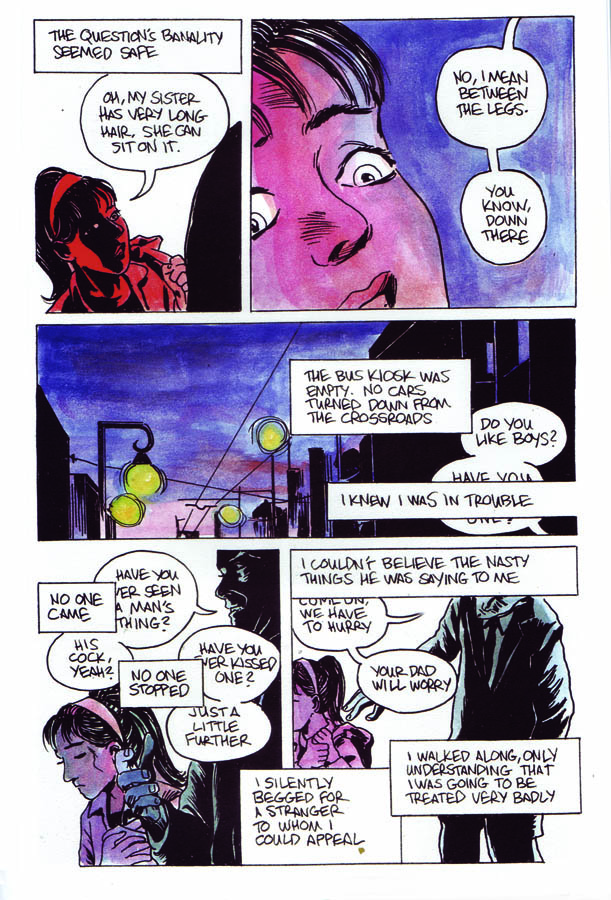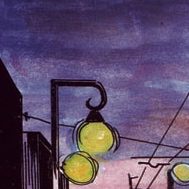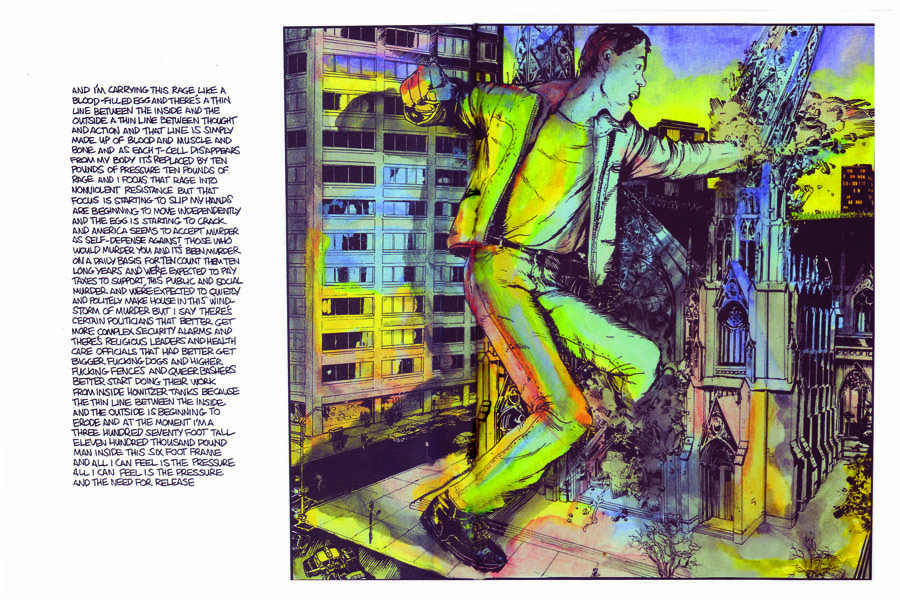The New York Comics & Picture-Story Symposium is a weekly forum for discussing the tradition and future of text/image work. Open to the public, it meets Tuesday nights 7-9 p.m. EST in New York City. Presentations vary weekly and include everything from historical topics and technical demonstrations to creators presenting their work. Check out upcoming meetings here.
*
The 110th meeting of the NY Comics & Picture-Story Symposium was held on Tuesday, December 2, 2014. Marguerite Van Cook and James Romberger presented their graphic novel The Late Child and Other Animals.
A decade after Hetty Martin survives the bombing of Portsmouth by the Nazis in World War II, she gives birth to a child out of wedlock, Marguerite. Now Hetty must go before a tribunal to prove that she is a fit mother. From there, The Late Child and Other Animals tells the story of Marguerite’s childhood in the recovering British naval port and the rural beauty of the Isle of Wight and in Normandy, France. The journeys and struggles over decades of this mother and daughter are linked in five episodes that veer between lyricism, wry wit, and harrowing suspense.
*
I.
Marguerite Van Cook and James Romberger have an idiosyncratic working relationship. They playfully prompted each other during the presentation of their latest graphic novel, The Late Child and Other Animals (Fantagraphics) at Ben Katchor’s New York Comics and Picture-Story Symposium. James pushed the computer keys to advance the projected images as Van Cook did a dramatic reading of the text. He would speed up and slow down. So would she. They are clearly experienced partners at telling stories. (A family tradition is emerging here—son Crosby has written and performed a rap accompaniment to his father James’s apocalyptic graphic novel Post York to considerable critical acclaim.)
The Late Child, written and colored by Van Cook and drawn by Romberger, is Van Cook’s first direct autobiography. She retells childhood memories of early dance classes and being followed home from school by a potential sex offender, speaking in the various British dialects that only a native speaker could reproduce.  “The spoiler” Van Cook revealed upon ending the scene with the would-be assaulter, “is that I’m is still here.”
“The spoiler” Van Cook revealed upon ending the scene with the would-be assaulter, “is that I’m is still here.”
The couple’s first major project, a loosely autobiographical story titled “Ground Zero,” was published irregularly among different publications soon after they first met (they look forward to collecting it into a single volume). At the time, Van Cook was into Roland Barthes, Winsor McCay, color theory, “and all that good stuff.” She and Romberger were hell-bent on demolishing as many conventions of the comic medium as they could. Not even the multi-panel grid was sacrosanct. Van Cook spoke with fondness about the ambition of “disrupting and insulting the page” whenever possible. “This was going to be work on the part of the reader,” she recalled with some glee, reiterating that they even scattered it in different publications so anyone who wanted to read the story really had to track it down!
Romberger and Van Cook then made a considerable smash with 7 Miles a Second, a powerful graphic novel written by David Wojnarowicz about his childhood as a street hustler in New York City, first published by DC Comics’s Vertigo label and later released by Fantagraphics. 7 Miles a Second was one of the first graphic novels to credit the colorist on the cover as one of three co-authors. Here, Van Cook broke new ground with an entirely unorthodox and uncompromising style of coloring.
The nighttime world of the street hustler in New York City world is lit by garish, clashing bright neon signs and street lights. Van Cook used a palette unrivaled in its aggressiveness. She knew the author David Wojnarowicz so intimately that even after he died, she understood the need for her choices of color on his story. Without the radical pinks and yellows, the novel would not have properly told Wojnarowic’s story. The aim was to make it egregious—even horrific. It’s not a rational world, and so oughtn’t take a rational palette.
An amusing note: once Van Cook’s prowess as a colorist became known throughout the comic industry, one editor pointed to a portion of a story and directed her, “I’d like you to do that spontaneous stuff—right here!”
II.
The Late Child is as decided a leap from 7 Miles as 7 Miles was from what had come before. Coloristically, here Van Cook did not want to assault the senses. It was to be a subtler, more pastel palette. She made sure that the brush strokes of Romberger’s ink could be seen. In collaboration, James Romberger executed his brushwork with a more delicate feel. “Color stops the action,” explains Van Cook to Romberger, “and tends to slow everything down. Color will tend to flatten the black and white. You have to keep the movement in the coloring.” “Keep it moving!” shouted Van Cook to Romberger, smiling.
This is Marguerite Van Cook’s first wholly autobiographical story. She wrote her reminiscences into a script, and gave it to Romberger to draw. “James’s drawings were gifts for me,” so attuned was his artwork to the needs of the story Van Cook had to tell. Romberger’s role was less that of an illustrator than that of a partner. Opening on a huge double-page spread of explosion is a primary example of where he left space for Van Cook to color. There are even touches in Late Child that can be described as cinematic, making use of Van Cook’s background in film.
Van Cook’s masters are among the European graphic novels—indeed, Late Child has the look and feel of a European graphic novel, particularly reminiscent of Philippe Druillet’s work (an early love of Van Cook, along with early Metal Hurlant ). Romberger and Van Cook also admire the work Lynn Varley did on Frank Miller’s Ronin , and the color Jim Steranko has done for his own comics. A final inspiration, oddly enough, comes from old daily comics printed on aging newsprint, with their imperfect four-color bleeding, blotching, and printing a little out of register. Romberger is thrilled with what Van Cook does, and every touch James puts in gets used. Nothing is wasted.
III.
Comics, Van Cook claims, are a perfect medium for autobiography. You can put yourself back into the moment and employ techniques to make the scenes move as you need to. For instance, during the scene in which the young Marguerite is being approached by her stalker, the placement of narrative boxes and dialogue in overlapping layers scatters the villain’s dialogue and the thoughts of his young victim. And Van Cook’s story is compelling. British schools denied her admission at one point because her parents weren’t married. (Romberger is aghast that “illegitimacy” is a big deal in our culture. “What century is this?” he asks.) At one point, she was adopted by her own mother. A sister was adopted. There was a death of a father. It’s impressive to hear her recount the difficulties of her life with a charming and effortless sense of humor.
Van Cook also draws from her background as a filmmaker, and gives credit to Kubrick’s Barry Lyndon, the candlelight scene in particular, for inspiration. The two traveled to the south of France so Marguerite could make a film that it is not yet finished, and probably won’t be. As with their graphic novels, these “unmade movies” that “untell the story” flout convention at every opportunity.
“As a girl in school,” Van Cook proclaims, “I didn’t color inside the lines. Why would anyone want to?”
***
Image credits:
Image 1: A frightened little girl, from Late Child and Other Animals (Fantagraphics, 2014) © by Marguerite Van Cook and James Romberger.
Image 2: Paranoid dementia in the big city. From 7 Miles a Second, (Fantagraphics, 2012) © by James Romberger, Marguerite Van Cook, and the estate of David Wojnarowicz.
***
Marguerite Van Cook came to New York her punk with band The Innocents, after touring the UK with The Clash. She stayed and opened the seminal installation gallery Ground Zero with her partner James Romberger. Her own works as an artist and filmmaker have placed her in many museum collections. Her current generational graphic memoir The Late Child and Other Animals with James Romberger (Fantagraphics) has been translated and published in France under the title L’Enfant inattendue. Her color work on the graphic memoir 7 Miles a Second, a collaborative project with James Romberger and the late David Wojnarowicz garnered her a nomination for an 2014 Eisner award for Best Painter/Multimedia Artist.
James Romberger‘s ecological comic Post York was published in 2012 by Uncivilized Books; it includes a flexi-disc by his son Crosby and it was nominated for an 2013 Eisner award for Best Single Issue. Romberger collaborated with Marguerite Van Cook and the late writer, artist and AIDS activist David Wojnarowicz on the critically acclaimed graphic novel 7 Miles A Second, which was first published in 1996 by DC/Vertigo and then released in a revised, expanded edition in February 2013 by Fantagraphics Books.
***
About the author: Mark Lerer holds a bachelor’s degree from Princeton University and an M.F.A. from the New York Academy of Art. His cartoon drawings have been published in the New York Post, have appeared at New Century Artists and Nexus galleries, and are regularly featured on Facebook.




